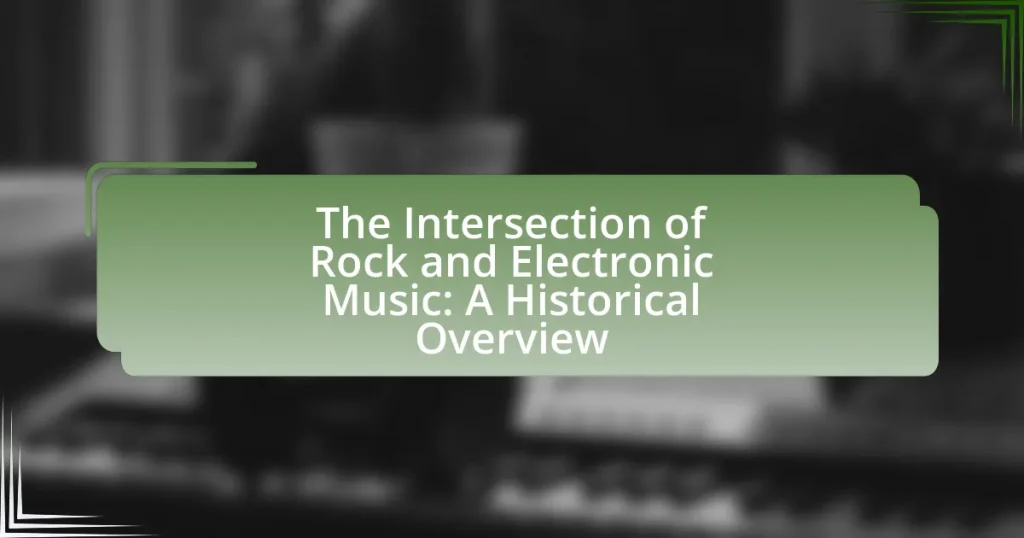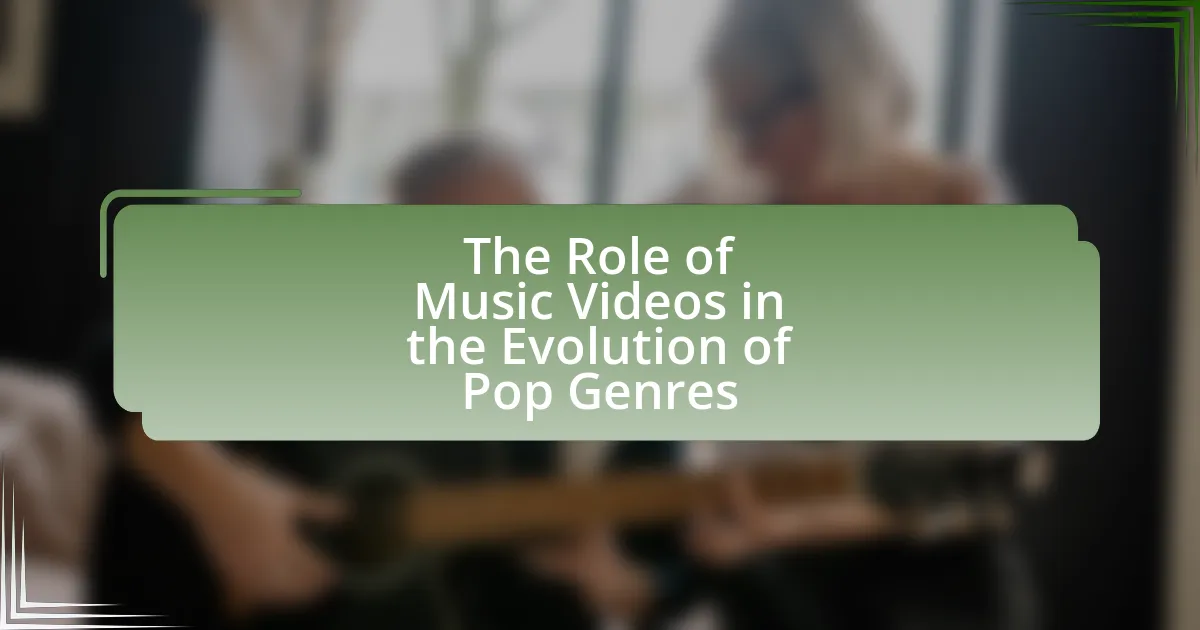The article explores the intersection of rock and electronic music, detailing its historical evolution and significance in music history. It highlights key moments, such as the incorporation of synthesizers by artists like The Beatles and Kraftwerk, and the emergence of genres like synth-pop and electronic rock. The discussion includes the impact of technological advancements, cultural movements, and notable collaborations that have shaped both genres. Additionally, it examines the characteristics, production techniques, and subgenres that define this fusion, as well as future trends and emerging artists pushing the boundaries of this musical intersection.
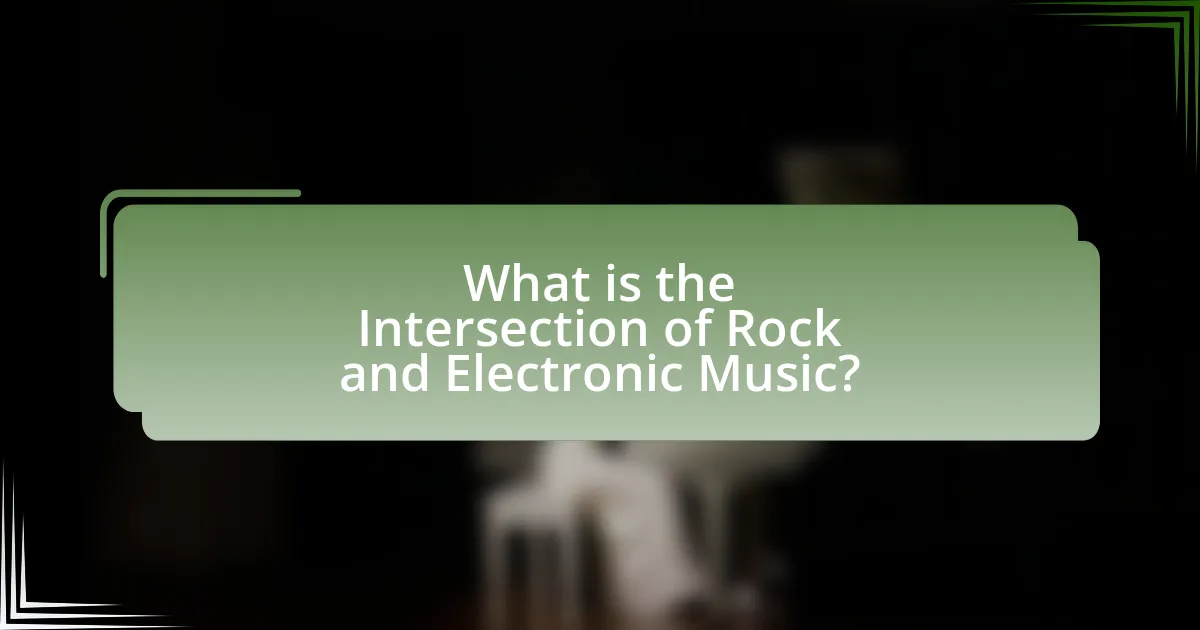
What is the Intersection of Rock and Electronic Music?
The intersection of rock and electronic music is characterized by the fusion of traditional rock instrumentation and structures with electronic production techniques and sounds. This blending began in the late 1960s and early 1970s, with artists like The Beatles incorporating synthesizers and tape loops in albums such as “Sgt. Pepper’s Lonely Hearts Club Band.” The trend continued with bands like Kraftwerk, who pioneered electronic music while influencing rock artists. By the 1980s, genres like synth-pop emerged, featuring bands such as Depeche Mode and New Order, which combined rock elements with electronic beats and synthesizers. This intersection has evolved, leading to contemporary genres like electronic rock and indietronica, showcasing the ongoing influence of electronic music on rock.
How did Rock and Electronic Music evolve together?
Rock and electronic music evolved together through the integration of electronic instruments and technology into rock music, particularly from the 1960s onward. The introduction of synthesizers, drum machines, and effects pedals allowed rock artists to experiment with new sounds and production techniques, leading to the emergence of genres like progressive rock and electronic rock. For instance, bands such as Pink Floyd and Kraftwerk blended rock elements with electronic music, influencing the development of both genres. By the 1980s, the collaboration between rock musicians and electronic producers became more pronounced, as seen in the works of artists like David Bowie and Depeche Mode, who incorporated electronic sounds into their rock compositions, further solidifying the relationship between the two musical styles.
What key historical events influenced their convergence?
The convergence of rock and electronic music was significantly influenced by the advent of the synthesizer in the 1960s, which allowed rock musicians to explore new soundscapes. The release of the Moog synthesizer in 1964 marked a pivotal moment, as artists like The Beatles and The Beach Boys began incorporating electronic elements into their music. Additionally, the rise of disco in the 1970s, characterized by its use of electronic beats and production techniques, further bridged the gap between the two genres. The emergence of electronic rock bands such as Kraftwerk in the 1970s also played a crucial role, as they blended rock instrumentation with electronic sounds, influencing countless artists across both genres.
How did technological advancements impact both genres?
Technological advancements significantly transformed both rock and electronic music by introducing new instruments, production techniques, and distribution methods. In rock music, the advent of electric guitars, amplifiers, and effects pedals allowed for greater sound experimentation and volume, leading to the development of subgenres like hard rock and punk. In electronic music, innovations such as synthesizers, drum machines, and digital audio workstations enabled artists to create complex soundscapes and manipulate audio in ways previously unimaginable. The rise of the internet and digital platforms further revolutionized both genres by facilitating global distribution and access to music, allowing artists to reach wider audiences and collaborate across geographical boundaries.
Why is the intersection significant in music history?
The intersection of rock and electronic music is significant in music history because it represents a transformative fusion that reshaped musical genres and cultural landscapes. This convergence began in the late 1960s and early 1970s, with artists like The Beatles incorporating electronic elements into their work, notably in the album “Revolver.” The use of synthesizers and electronic effects in rock music expanded the sonic possibilities, leading to the emergence of subgenres such as synth-pop and electronic rock. This blending of styles not only influenced mainstream music but also paved the way for future genres, including new wave and industrial music, demonstrating the lasting impact of this intersection on the evolution of contemporary music.
What cultural movements contributed to this fusion?
The cultural movements that contributed to the fusion of rock and electronic music include the counterculture of the 1960s, the rise of disco in the 1970s, and the emergence of punk and new wave in the late 1970s and early 1980s. The counterculture movement, characterized by its rejection of mainstream values and exploration of new artistic expressions, encouraged rock musicians to experiment with electronic instruments and sounds. Disco, with its emphasis on rhythm and dance, influenced rock artists to incorporate electronic beats and synthesizers into their music. Additionally, the punk and new wave movements embraced technology and DIY aesthetics, leading to innovative uses of electronic elements in rock music. These movements collectively shaped the landscape of music, allowing for a seamless blending of genres and the creation of new sounds.
How has this intersection shaped modern music trends?
The intersection of rock and electronic music has significantly shaped modern music trends by fostering the emergence of genres such as synth-pop, electronic rock, and industrial music. This blending of styles has led to innovative soundscapes that incorporate electronic instrumentation and production techniques, which have become staples in contemporary music. For instance, the use of synthesizers and drum machines in rock music, popularized by bands like Depeche Mode and Nine Inch Nails, has influenced countless artists across various genres, including pop, hip-hop, and dance music. The integration of these elements has not only expanded the sonic possibilities within rock but has also paved the way for the mainstream acceptance of electronic music, as seen in the success of artists like Billie Eilish and The Weeknd, who incorporate both rock and electronic influences in their work.
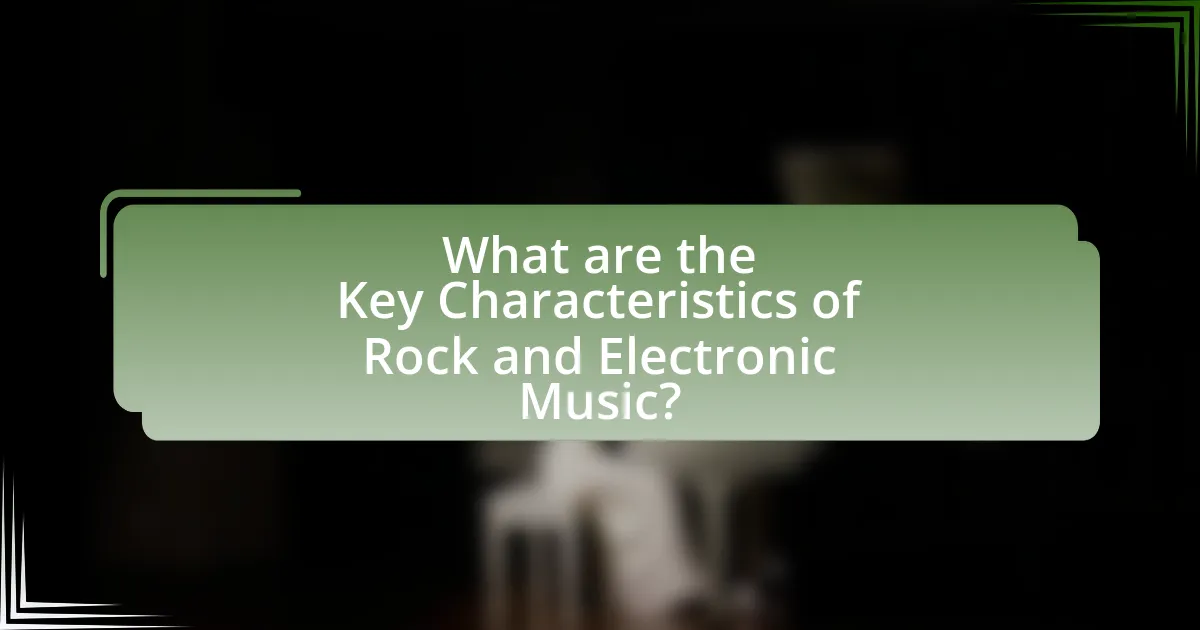
What are the Key Characteristics of Rock and Electronic Music?
Rock music is characterized by its use of electric guitars, strong rhythms, and often features vocals with emotional expression, while electronic music is defined by its use of synthesizers, drum machines, and digital production techniques. Rock typically emphasizes live instrumentation and a band format, often incorporating elements like guitar solos and lyrical storytelling. In contrast, electronic music focuses on sound manipulation and layering, often creating immersive soundscapes and beats that can be produced and performed in various settings, including clubs and festivals. The historical evolution of both genres shows their intersection, particularly in the late 20th century, where artists like David Bowie and Radiohead blended rock elements with electronic sounds, showcasing the adaptability and fusion of these musical styles.
How do the musical elements of Rock and Electronic differ?
Rock music primarily relies on traditional instruments such as electric guitars, bass, and drums, emphasizing live performance and organic sound, while electronic music predominantly utilizes synthesizers, drum machines, and computer software, focusing on digital production and sound manipulation. The rhythmic structure in rock often features straightforward beats and time signatures, whereas electronic music frequently employs complex rhythms and varying tempos, allowing for greater experimentation. Additionally, rock music typically emphasizes vocal melodies and lyrical storytelling, while electronic music often prioritizes instrumental soundscapes and textures, creating immersive auditory experiences. These distinctions highlight the contrasting approaches to instrumentation, rhythm, and composition in both genres.
What instruments are commonly used in each genre?
Rock music commonly utilizes electric guitars, bass guitars, drums, and keyboards, while electronic music primarily employs synthesizers, drum machines, and samplers. The electric guitar is a defining instrument in rock, contributing to its signature sound since the 1950s, while synthesizers have been central to electronic music since the 1960s, shaping its distinct sonic landscape. The use of these instruments reflects the evolution and blending of both genres, with rock bands increasingly incorporating electronic elements and electronic artists drawing inspiration from rock instrumentation.
How do production techniques vary between Rock and Electronic music?
Production techniques in Rock and Electronic music differ significantly in their approach and execution. Rock music typically emphasizes live instrumentation, where musicians perform together in a studio setting, capturing the energy of the performance through techniques like mic placement and analog recording. In contrast, Electronic music relies heavily on digital production, utilizing software and synthesizers to create sounds, often involving sampling, looping, and MIDI programming.
For instance, Rock often employs techniques such as multi-tracking, where individual instruments are recorded separately and mixed later, while Electronic music frequently uses sound design and manipulation, allowing for a broader range of sonic possibilities. The use of effects like reverb and distortion is common in Rock to enhance the live sound, whereas Electronic music may incorporate complex layering and automation to create dynamic shifts in texture and rhythm.
These differences are rooted in the historical contexts of each genre; Rock emerged from live performance traditions, while Electronic music evolved with advancements in technology, leading to distinct production methodologies that reflect their unique artistic goals.
What subgenres emerged from the fusion of Rock and Electronic music?
Subgenres that emerged from the fusion of Rock and Electronic music include Synthpop, Industrial Rock, and Electronicore. Synthpop originated in the late 1970s and early 1980s, characterized by the use of synthesizers and drum machines, with bands like Depeche Mode and Kraftwerk exemplifying this style. Industrial Rock, which gained prominence in the 1980s and 1990s, combines rock elements with electronic music, featuring artists such as Nine Inch Nails and Ministry. Electronicore, a more recent subgenre, blends metalcore with electronic music, represented by bands like Attack Attack! and Asking Alexandria. These subgenres illustrate the diverse outcomes of the Rock and Electronic music fusion.
What defines genres like Synthrock and Electronic Rock?
Synthrock and Electronic Rock are defined by their fusion of traditional rock elements with electronic music components. Synthrock incorporates synthesizers, drum machines, and other electronic instruments while maintaining rock’s rhythmic and melodic structures, exemplified by bands like Depeche Mode and The Human League. Electronic Rock, on the other hand, emphasizes the use of electronic production techniques and sound manipulation, often blending rock guitar riffs with electronic beats, as seen in the works of artists like Nine Inch Nails and Radiohead. This genre evolution reflects a historical shift in music technology and cultural trends, particularly from the late 1970s onward, when synthesizers became more accessible and influential in popular music.
How have these subgenres influenced mainstream music?
Subgenres of rock and electronic music have significantly influenced mainstream music by introducing innovative sounds and production techniques. For instance, the emergence of electronic rock in the late 1970s, exemplified by bands like Kraftwerk, integrated synthesizers and drum machines, which reshaped the sonic landscape of popular music. This fusion led to the rise of genres such as synth-pop and new wave in the 1980s, with artists like Depeche Mode and Duran Duran achieving commercial success. Additionally, the incorporation of rock elements into electronic dance music (EDM) has created crossover hits, as seen in the works of artists like The Chainsmokers and Calvin Harris, who blend rock guitar riffs with electronic beats, further solidifying the impact of these subgenres on mainstream music.
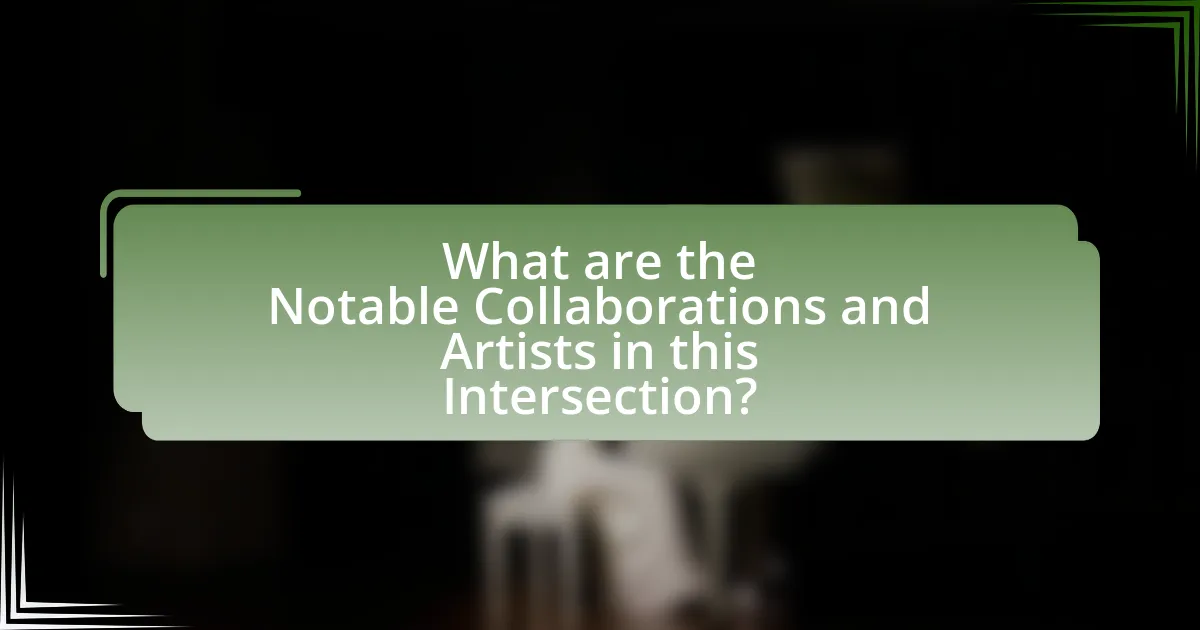
What are the Notable Collaborations and Artists in this Intersection?
Notable collaborations and artists in the intersection of rock and electronic music include David Bowie and Brian Eno, who worked together on the “Berlin Trilogy,” blending rock with electronic soundscapes. Another significant collaboration is between the band Radiohead and producer Nigel Godrich, particularly on the album “Kid A,” which incorporated electronic elements into their rock foundation. Additionally, the group Nine Inch Nails, led by Trent Reznor, is known for merging industrial rock with electronic music, exemplified in albums like “The Downward Spiral.” These collaborations highlight the successful fusion of genres, influencing the evolution of both rock and electronic music.
Which artists are known for blending Rock and Electronic music?
Artists known for blending Rock and Electronic music include Nine Inch Nails, Radiohead, and Daft Punk. Nine Inch Nails, led by Trent Reznor, is recognized for integrating industrial rock with electronic elements, particularly in albums like “The Downward Spiral.” Radiohead has experimented with electronic sounds in albums such as “Kid A,” merging alternative rock with ambient and electronic influences. Daft Punk, while primarily an electronic duo, has incorporated rock elements in tracks like “Harder, Better, Faster, Stronger,” showcasing a fusion of genres. These artists exemplify the successful integration of rock and electronic music, influencing the evolution of both genres.
What impact did artists like Daft Punk and Nine Inch Nails have?
Artists like Daft Punk and Nine Inch Nails significantly influenced the fusion of electronic music with rock, shaping contemporary music genres. Daft Punk popularized house music and electronic elements in mainstream pop, particularly with their album “Discovery,” which introduced a new sound characterized by catchy melodies and robotic vocals. Nine Inch Nails, on the other hand, integrated industrial rock with electronic music, exemplified by their album “The Downward Spiral,” which showcased a blend of aggressive guitar riffs and electronic beats. Both artists have been pivotal in expanding the boundaries of their respective genres, inspiring countless musicians and contributing to the evolution of electronic music in popular culture.
How have collaborations between Rock and Electronic artists evolved?
Collaborations between Rock and Electronic artists have evolved significantly from the late 20th century to the present day, transitioning from experimental fusions to mainstream integrations. Initially, in the 1980s, artists like David Bowie and bands such as The Cure began incorporating electronic elements into rock music, paving the way for future collaborations. By the 1990s, the rise of genres like trip-hop and industrial rock saw bands such as Nine Inch Nails collaborating with electronic producers, exemplifying a deeper integration of both styles.
In the 2000s, collaborations became more prominent, with artists like Linkin Park partnering with electronic musicians such as Jay Gordon of Orgy, blending rock with electronic sounds in a commercially successful manner. The trend continued into the 2010s, where artists like Muse and The Prodigy showcased a seamless blend of rock and electronic music, appealing to a broader audience.
Recent collaborations, such as those between Marshmello and rock bands like Bastille, illustrate the current trend of merging genres for wider appeal, reflecting a shift towards genre fluidity in the music industry. This evolution highlights a growing acceptance and exploration of hybrid sounds, driven by technological advancements and changing listener preferences.
What are some landmark albums that exemplify this fusion?
Landmark albums that exemplify the fusion of rock and electronic music include “Dark Side of the Moon” by Pink Floyd, “OK Computer” by Radiohead, and “Discovery” by Daft Punk. “Dark Side of the Moon,” released in 1973, integrates synthesizers and sound effects, showcasing the experimental side of rock. “OK Computer,” released in 1997, blends rock with electronic elements, reflecting themes of technology and alienation. “Discovery,” released in 2001, combines house music with rock influences, marking a significant moment in the evolution of electronic music. These albums are pivotal in demonstrating how rock and electronic genres can intersect and influence each other.
How did these albums change the landscape of both genres?
These albums significantly transformed the landscape of both rock and electronic music by introducing innovative sounds and production techniques that blurred genre boundaries. For instance, the incorporation of synthesizers and electronic beats in rock albums led to the emergence of subgenres like synth-rock and electronic rock, which expanded the sonic possibilities of traditional rock music. Additionally, albums such as “Dark Side of the Moon” by Pink Floyd and “Computer World” by Kraftwerk showcased the potential of electronic instrumentation, influencing countless artists across both genres. This cross-pollination not only diversified the musical palette but also paved the way for future collaborations and hybrid genres, ultimately reshaping the music industry and listener expectations.
What critical reception did these albums receive upon release?
The albums received a generally positive critical reception upon release, with many reviewers praising their innovative blend of rock and electronic elements. For instance, critics highlighted the groundbreaking production techniques and the fusion of genres, which were seen as ahead of their time. Publications such as Rolling Stone and Pitchfork noted the albums’ influence on subsequent music, emphasizing their role in shaping the sound of the late 20th century. Specific reviews often cited standout tracks that showcased the successful integration of electronic sounds into traditional rock frameworks, further solidifying their acclaim in the music industry.
What are the Future Trends in the Intersection of Rock and Electronic Music?
Future trends in the intersection of rock and electronic music include increased collaboration between artists from both genres, the integration of advanced technology in live performances, and the rise of hybrid subgenres. Collaborations are becoming more common as artists seek to blend the raw energy of rock with the innovative sounds of electronic music, exemplified by projects like the collaboration between The Prodigy and rock bands. Advanced technology, such as virtual reality and AI-driven music production, is enhancing live performances, allowing for immersive experiences that engage audiences in new ways. Additionally, hybrid subgenres, such as electronic rock and synth-pop, are gaining popularity, reflecting a growing acceptance and experimentation within the music industry. These trends indicate a dynamic evolution in how rock and electronic music influence each other, shaping the future landscape of both genres.
How might technology continue to influence this musical fusion?
Technology will continue to influence the fusion of rock and electronic music through advancements in digital audio production and distribution. Digital audio workstations (DAWs) enable musicians to blend genres seamlessly, allowing for innovative sound design and manipulation. For instance, the use of software synthesizers and samplers has expanded the sonic palette available to rock musicians, facilitating the incorporation of electronic elements into traditional rock structures. Additionally, streaming platforms and social media provide artists with unprecedented access to global audiences, promoting cross-genre collaborations and the sharing of diverse musical influences. This ongoing evolution is evidenced by the rise of artists like Nine Inch Nails and Radiohead, who have successfully integrated electronic techniques into their rock music, demonstrating the transformative impact of technology on genre boundaries.
What emerging artists are pushing the boundaries of this intersection?
Emerging artists pushing the boundaries of the intersection of rock and electronic music include Yves Tumor, who blends experimental rock with electronic soundscapes, and Grimes, known for her fusion of pop, rock, and electronic elements. Additionally, artists like SOPHIE have significantly influenced the genre by incorporating avant-garde electronic production techniques into their music, creating a unique sound that challenges traditional rock norms. These artists exemplify the innovative spirit at this intersection, as evidenced by their critical acclaim and influence on contemporary music trends.
